ECOM 421: E-Business Revenue Models - Advantages and Disadvantages
VerifiedAdded on 2022/08/14
|9
|2050
|19
Essay
AI Summary
This essay delves into the realm of e-business revenue models, providing a comprehensive overview of their concepts and types. It begins by defining e-business and its revenue generation methods, followed by a discussion of five primary models: advertising, subscription, transaction fee, sales, and affiliate. The essay elaborates on each model, explaining how they function and generate revenue. Furthermore, it explores the advantages of e-business revenue models, such as increased convenience, wider market reach, and cost savings, while also addressing the disadvantages, including the need for customer trust and security. The essay concludes with a summary of the key points, emphasizing the importance of e-business models in the digital age and their potential for growth, while acknowledging the associated challenges.
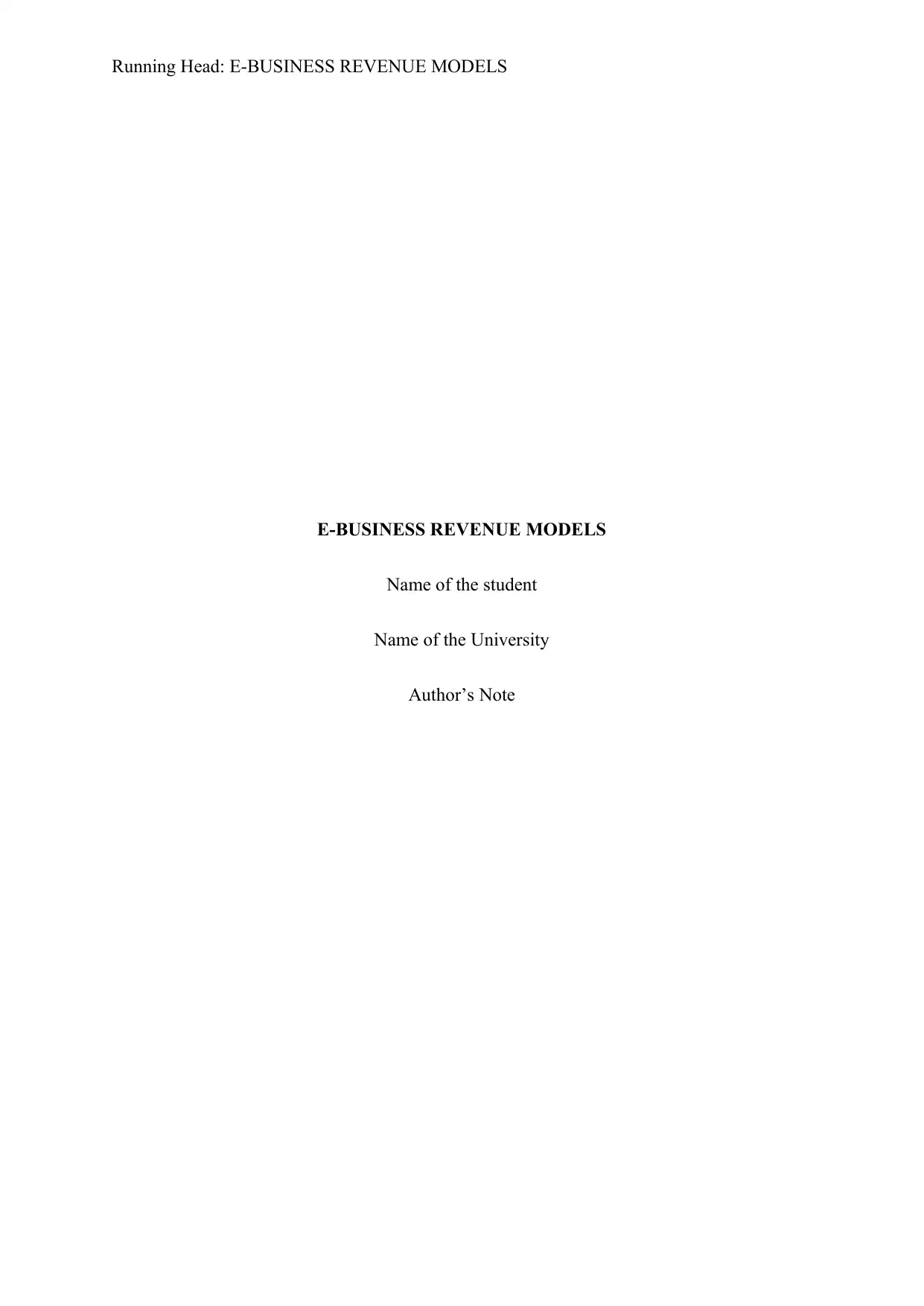
Running Head: E-BUSINESS REVENUE MODELS
E-BUSINESS REVENUE MODELS
Name of the student
Name of the University
Author’s Note
E-BUSINESS REVENUE MODELS
Name of the student
Name of the University
Author’s Note
Paraphrase This Document
Need a fresh take? Get an instant paraphrase of this document with our AI Paraphraser

E-BUSINESS REVENUE MODELS
Table of Contents
Introduction................................................................................................................................3
Discussion..................................................................................................................................3
Conclusion..................................................................................................................................7
References..................................................................................................................................8
Page 1 of 9
Table of Contents
Introduction................................................................................................................................3
Discussion..................................................................................................................................3
Conclusion..................................................................................................................................7
References..................................................................................................................................8
Page 1 of 9
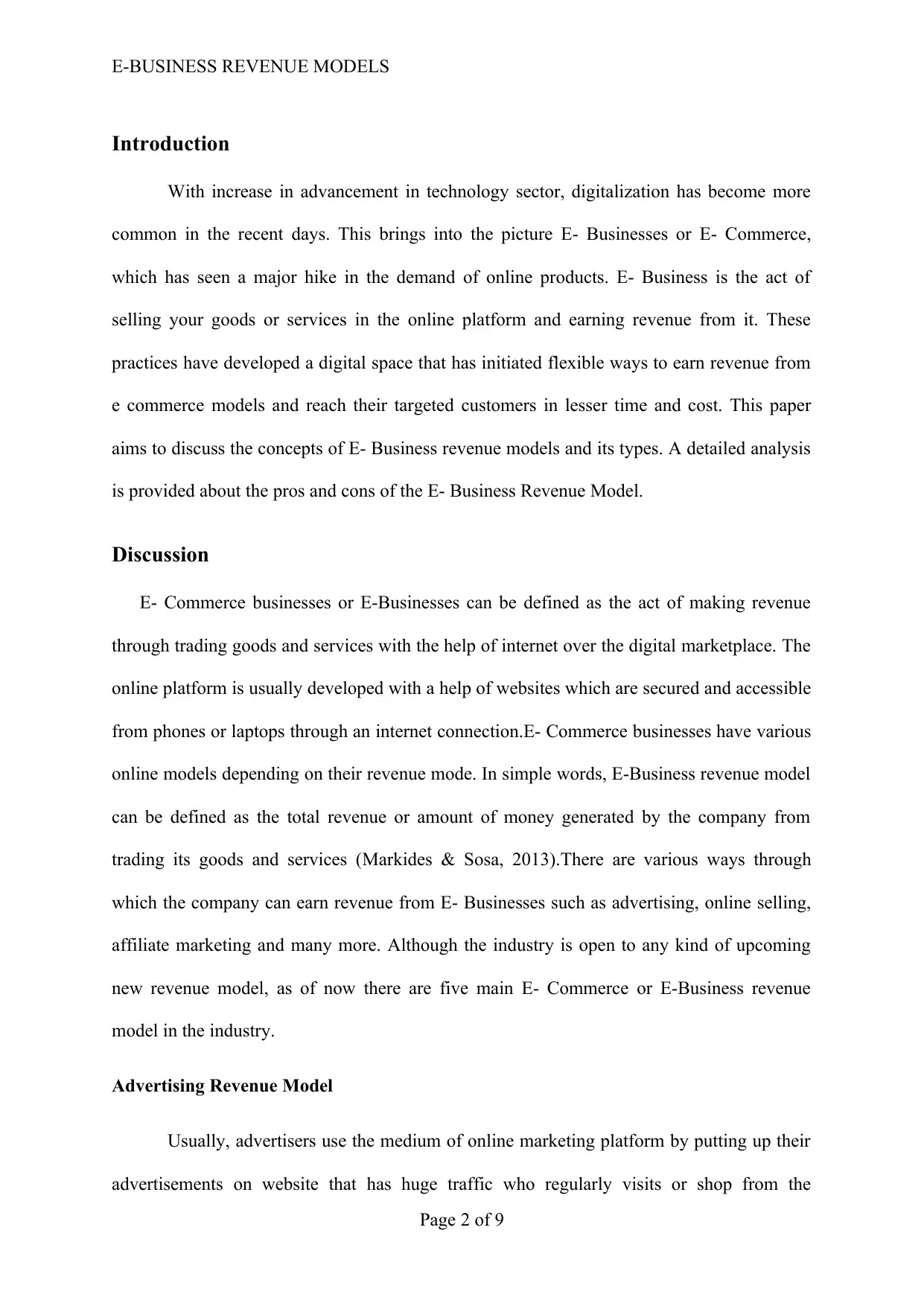
E-BUSINESS REVENUE MODELS
Introduction
With increase in advancement in technology sector, digitalization has become more
common in the recent days. This brings into the picture E- Businesses or E- Commerce,
which has seen a major hike in the demand of online products. E- Business is the act of
selling your goods or services in the online platform and earning revenue from it. These
practices have developed a digital space that has initiated flexible ways to earn revenue from
e commerce models and reach their targeted customers in lesser time and cost. This paper
aims to discuss the concepts of E- Business revenue models and its types. A detailed analysis
is provided about the pros and cons of the E- Business Revenue Model.
Discussion
E- Commerce businesses or E-Businesses can be defined as the act of making revenue
through trading goods and services with the help of internet over the digital marketplace. The
online platform is usually developed with a help of websites which are secured and accessible
from phones or laptops through an internet connection.E- Commerce businesses have various
online models depending on their revenue mode. In simple words, E-Business revenue model
can be defined as the total revenue or amount of money generated by the company from
trading its goods and services (Markides & Sosa, 2013).There are various ways through
which the company can earn revenue from E- Businesses such as advertising, online selling,
affiliate marketing and many more. Although the industry is open to any kind of upcoming
new revenue model, as of now there are five main E- Commerce or E-Business revenue
model in the industry.
Advertising Revenue Model
Usually, advertisers use the medium of online marketing platform by putting up their
advertisements on website that has huge traffic who regularly visits or shop from the
Page 2 of 9
Introduction
With increase in advancement in technology sector, digitalization has become more
common in the recent days. This brings into the picture E- Businesses or E- Commerce,
which has seen a major hike in the demand of online products. E- Business is the act of
selling your goods or services in the online platform and earning revenue from it. These
practices have developed a digital space that has initiated flexible ways to earn revenue from
e commerce models and reach their targeted customers in lesser time and cost. This paper
aims to discuss the concepts of E- Business revenue models and its types. A detailed analysis
is provided about the pros and cons of the E- Business Revenue Model.
Discussion
E- Commerce businesses or E-Businesses can be defined as the act of making revenue
through trading goods and services with the help of internet over the digital marketplace. The
online platform is usually developed with a help of websites which are secured and accessible
from phones or laptops through an internet connection.E- Commerce businesses have various
online models depending on their revenue mode. In simple words, E-Business revenue model
can be defined as the total revenue or amount of money generated by the company from
trading its goods and services (Markides & Sosa, 2013).There are various ways through
which the company can earn revenue from E- Businesses such as advertising, online selling,
affiliate marketing and many more. Although the industry is open to any kind of upcoming
new revenue model, as of now there are five main E- Commerce or E-Business revenue
model in the industry.
Advertising Revenue Model
Usually, advertisers use the medium of online marketing platform by putting up their
advertisements on website that has huge traffic who regularly visits or shop from the
Page 2 of 9
⊘ This is a preview!⊘
Do you want full access?
Subscribe today to unlock all pages.

Trusted by 1+ million students worldwide
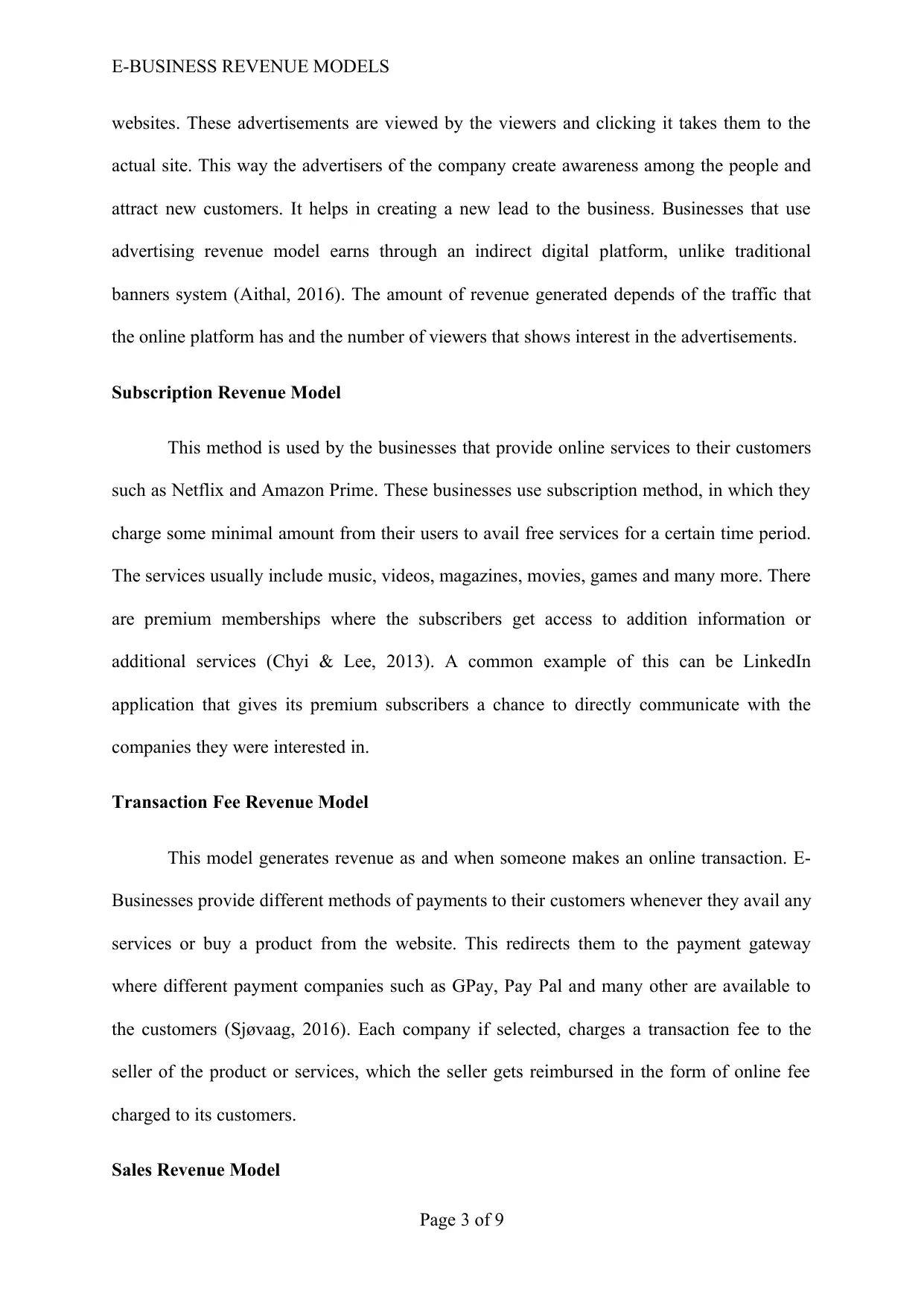
E-BUSINESS REVENUE MODELS
websites. These advertisements are viewed by the viewers and clicking it takes them to the
actual site. This way the advertisers of the company create awareness among the people and
attract new customers. It helps in creating a new lead to the business. Businesses that use
advertising revenue model earns through an indirect digital platform, unlike traditional
banners system (Aithal, 2016). The amount of revenue generated depends of the traffic that
the online platform has and the number of viewers that shows interest in the advertisements.
Subscription Revenue Model
This method is used by the businesses that provide online services to their customers
such as Netflix and Amazon Prime. These businesses use subscription method, in which they
charge some minimal amount from their users to avail free services for a certain time period.
The services usually include music, videos, magazines, movies, games and many more. There
are premium memberships where the subscribers get access to addition information or
additional services (Chyi & Lee, 2013). A common example of this can be LinkedIn
application that gives its premium subscribers a chance to directly communicate with the
companies they were interested in.
Transaction Fee Revenue Model
This model generates revenue as and when someone makes an online transaction. E-
Businesses provide different methods of payments to their customers whenever they avail any
services or buy a product from the website. This redirects them to the payment gateway
where different payment companies such as GPay, Pay Pal and many other are available to
the customers (Sjøvaag, 2016). Each company if selected, charges a transaction fee to the
seller of the product or services, which the seller gets reimbursed in the form of online fee
charged to its customers.
Sales Revenue Model
Page 3 of 9
websites. These advertisements are viewed by the viewers and clicking it takes them to the
actual site. This way the advertisers of the company create awareness among the people and
attract new customers. It helps in creating a new lead to the business. Businesses that use
advertising revenue model earns through an indirect digital platform, unlike traditional
banners system (Aithal, 2016). The amount of revenue generated depends of the traffic that
the online platform has and the number of viewers that shows interest in the advertisements.
Subscription Revenue Model
This method is used by the businesses that provide online services to their customers
such as Netflix and Amazon Prime. These businesses use subscription method, in which they
charge some minimal amount from their users to avail free services for a certain time period.
The services usually include music, videos, magazines, movies, games and many more. There
are premium memberships where the subscribers get access to addition information or
additional services (Chyi & Lee, 2013). A common example of this can be LinkedIn
application that gives its premium subscribers a chance to directly communicate with the
companies they were interested in.
Transaction Fee Revenue Model
This model generates revenue as and when someone makes an online transaction. E-
Businesses provide different methods of payments to their customers whenever they avail any
services or buy a product from the website. This redirects them to the payment gateway
where different payment companies such as GPay, Pay Pal and many other are available to
the customers (Sjøvaag, 2016). Each company if selected, charges a transaction fee to the
seller of the product or services, which the seller gets reimbursed in the form of online fee
charged to its customers.
Sales Revenue Model
Page 3 of 9
Paraphrase This Document
Need a fresh take? Get an instant paraphrase of this document with our AI Paraphraser
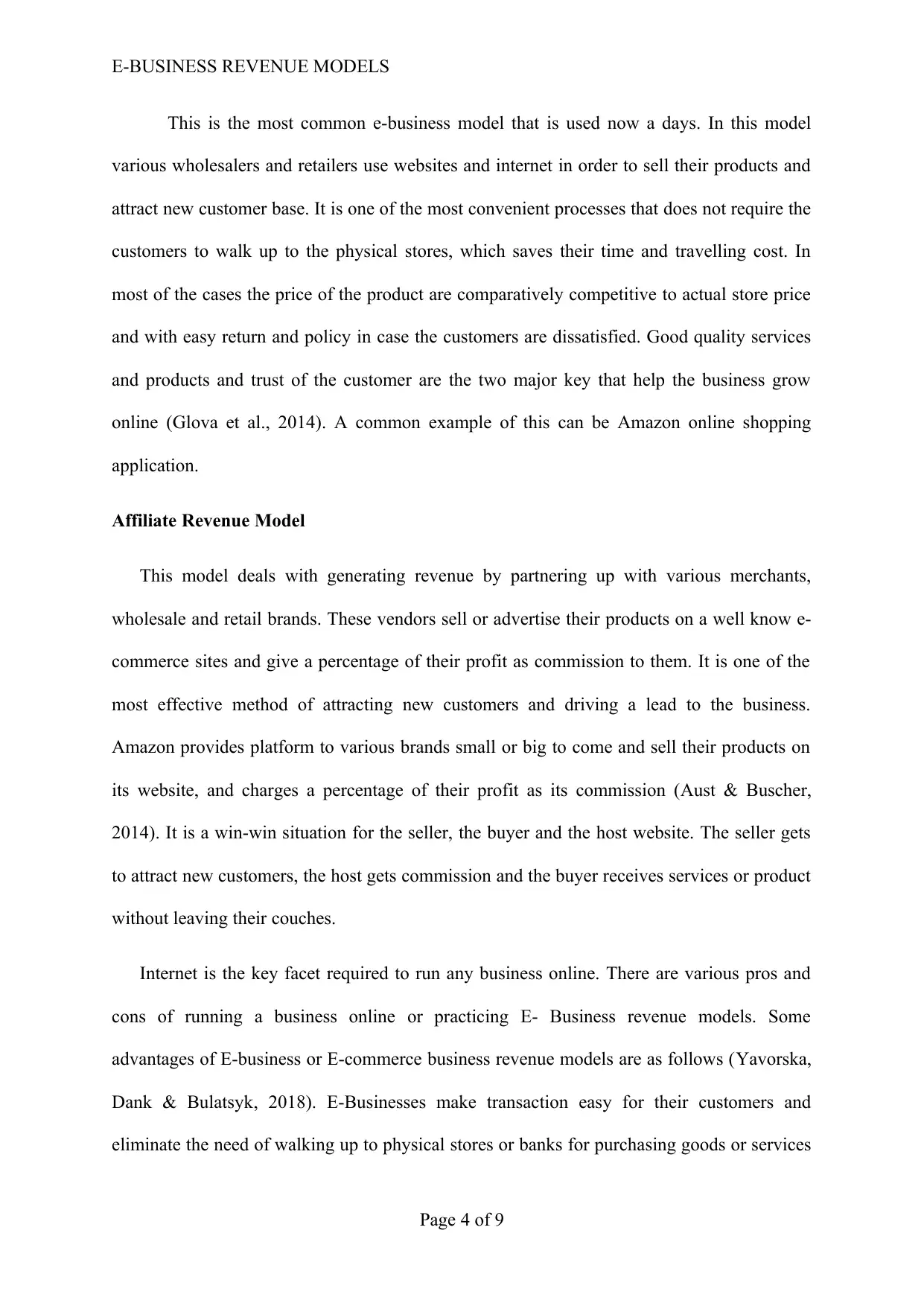
E-BUSINESS REVENUE MODELS
This is the most common e-business model that is used now a days. In this model
various wholesalers and retailers use websites and internet in order to sell their products and
attract new customer base. It is one of the most convenient processes that does not require the
customers to walk up to the physical stores, which saves their time and travelling cost. In
most of the cases the price of the product are comparatively competitive to actual store price
and with easy return and policy in case the customers are dissatisfied. Good quality services
and products and trust of the customer are the two major key that help the business grow
online (Glova et al., 2014). A common example of this can be Amazon online shopping
application.
Affiliate Revenue Model
This model deals with generating revenue by partnering up with various merchants,
wholesale and retail brands. These vendors sell or advertise their products on a well know e-
commerce sites and give a percentage of their profit as commission to them. It is one of the
most effective method of attracting new customers and driving a lead to the business.
Amazon provides platform to various brands small or big to come and sell their products on
its website, and charges a percentage of their profit as its commission (Aust & Buscher,
2014). It is a win-win situation for the seller, the buyer and the host website. The seller gets
to attract new customers, the host gets commission and the buyer receives services or product
without leaving their couches.
Internet is the key facet required to run any business online. There are various pros and
cons of running a business online or practicing E- Business revenue models. Some
advantages of E-business or E-commerce business revenue models are as follows (Yavorska,
Dank & Bulatsyk, 2018). E-Businesses make transaction easy for their customers and
eliminate the need of walking up to physical stores or banks for purchasing goods or services
Page 4 of 9
This is the most common e-business model that is used now a days. In this model
various wholesalers and retailers use websites and internet in order to sell their products and
attract new customer base. It is one of the most convenient processes that does not require the
customers to walk up to the physical stores, which saves their time and travelling cost. In
most of the cases the price of the product are comparatively competitive to actual store price
and with easy return and policy in case the customers are dissatisfied. Good quality services
and products and trust of the customer are the two major key that help the business grow
online (Glova et al., 2014). A common example of this can be Amazon online shopping
application.
Affiliate Revenue Model
This model deals with generating revenue by partnering up with various merchants,
wholesale and retail brands. These vendors sell or advertise their products on a well know e-
commerce sites and give a percentage of their profit as commission to them. It is one of the
most effective method of attracting new customers and driving a lead to the business.
Amazon provides platform to various brands small or big to come and sell their products on
its website, and charges a percentage of their profit as its commission (Aust & Buscher,
2014). It is a win-win situation for the seller, the buyer and the host website. The seller gets
to attract new customers, the host gets commission and the buyer receives services or product
without leaving their couches.
Internet is the key facet required to run any business online. There are various pros and
cons of running a business online or practicing E- Business revenue models. Some
advantages of E-business or E-commerce business revenue models are as follows (Yavorska,
Dank & Bulatsyk, 2018). E-Businesses make transaction easy for their customers and
eliminate the need of walking up to physical stores or banks for purchasing goods or services
Page 4 of 9
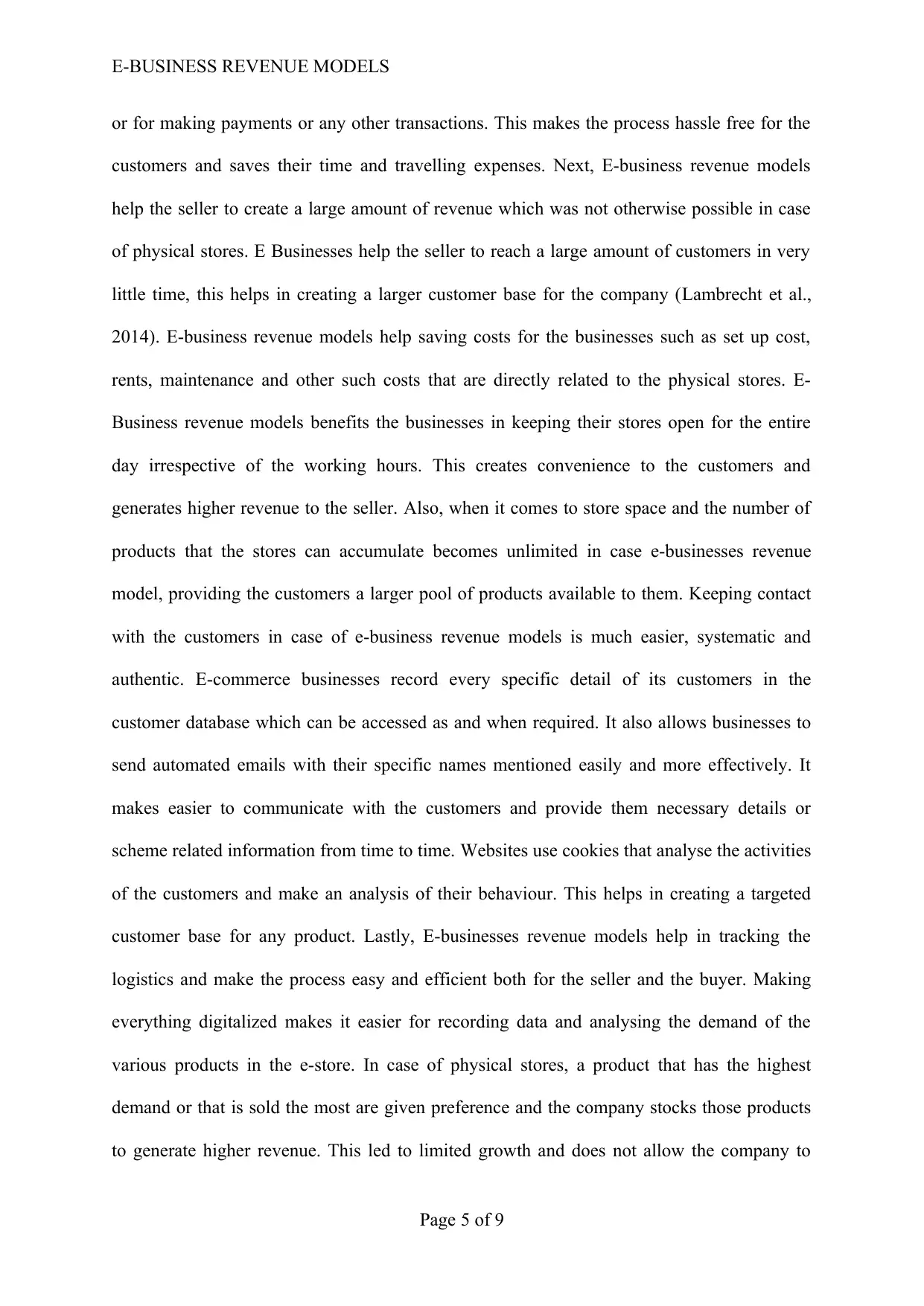
E-BUSINESS REVENUE MODELS
or for making payments or any other transactions. This makes the process hassle free for the
customers and saves their time and travelling expenses. Next, E-business revenue models
help the seller to create a large amount of revenue which was not otherwise possible in case
of physical stores. E Businesses help the seller to reach a large amount of customers in very
little time, this helps in creating a larger customer base for the company (Lambrecht et al.,
2014). E-business revenue models help saving costs for the businesses such as set up cost,
rents, maintenance and other such costs that are directly related to the physical stores. E-
Business revenue models benefits the businesses in keeping their stores open for the entire
day irrespective of the working hours. This creates convenience to the customers and
generates higher revenue to the seller. Also, when it comes to store space and the number of
products that the stores can accumulate becomes unlimited in case e-businesses revenue
model, providing the customers a larger pool of products available to them. Keeping contact
with the customers in case of e-business revenue models is much easier, systematic and
authentic. E-commerce businesses record every specific detail of its customers in the
customer database which can be accessed as and when required. It also allows businesses to
send automated emails with their specific names mentioned easily and more effectively. It
makes easier to communicate with the customers and provide them necessary details or
scheme related information from time to time. Websites use cookies that analyse the activities
of the customers and make an analysis of their behaviour. This helps in creating a targeted
customer base for any product. Lastly, E-businesses revenue models help in tracking the
logistics and make the process easy and efficient both for the seller and the buyer. Making
everything digitalized makes it easier for recording data and analysing the demand of the
various products in the e-store. In case of physical stores, a product that has the highest
demand or that is sold the most are given preference and the company stocks those products
to generate higher revenue. This led to limited growth and does not allow the company to
Page 5 of 9
or for making payments or any other transactions. This makes the process hassle free for the
customers and saves their time and travelling expenses. Next, E-business revenue models
help the seller to create a large amount of revenue which was not otherwise possible in case
of physical stores. E Businesses help the seller to reach a large amount of customers in very
little time, this helps in creating a larger customer base for the company (Lambrecht et al.,
2014). E-business revenue models help saving costs for the businesses such as set up cost,
rents, maintenance and other such costs that are directly related to the physical stores. E-
Business revenue models benefits the businesses in keeping their stores open for the entire
day irrespective of the working hours. This creates convenience to the customers and
generates higher revenue to the seller. Also, when it comes to store space and the number of
products that the stores can accumulate becomes unlimited in case e-businesses revenue
model, providing the customers a larger pool of products available to them. Keeping contact
with the customers in case of e-business revenue models is much easier, systematic and
authentic. E-commerce businesses record every specific detail of its customers in the
customer database which can be accessed as and when required. It also allows businesses to
send automated emails with their specific names mentioned easily and more effectively. It
makes easier to communicate with the customers and provide them necessary details or
scheme related information from time to time. Websites use cookies that analyse the activities
of the customers and make an analysis of their behaviour. This helps in creating a targeted
customer base for any product. Lastly, E-businesses revenue models help in tracking the
logistics and make the process easy and efficient both for the seller and the buyer. Making
everything digitalized makes it easier for recording data and analysing the demand of the
various products in the e-store. In case of physical stores, a product that has the highest
demand or that is sold the most are given preference and the company stocks those products
to generate higher revenue. This led to limited growth and does not allow the company to
Page 5 of 9
⊘ This is a preview!⊘
Do you want full access?
Subscribe today to unlock all pages.

Trusted by 1+ million students worldwide
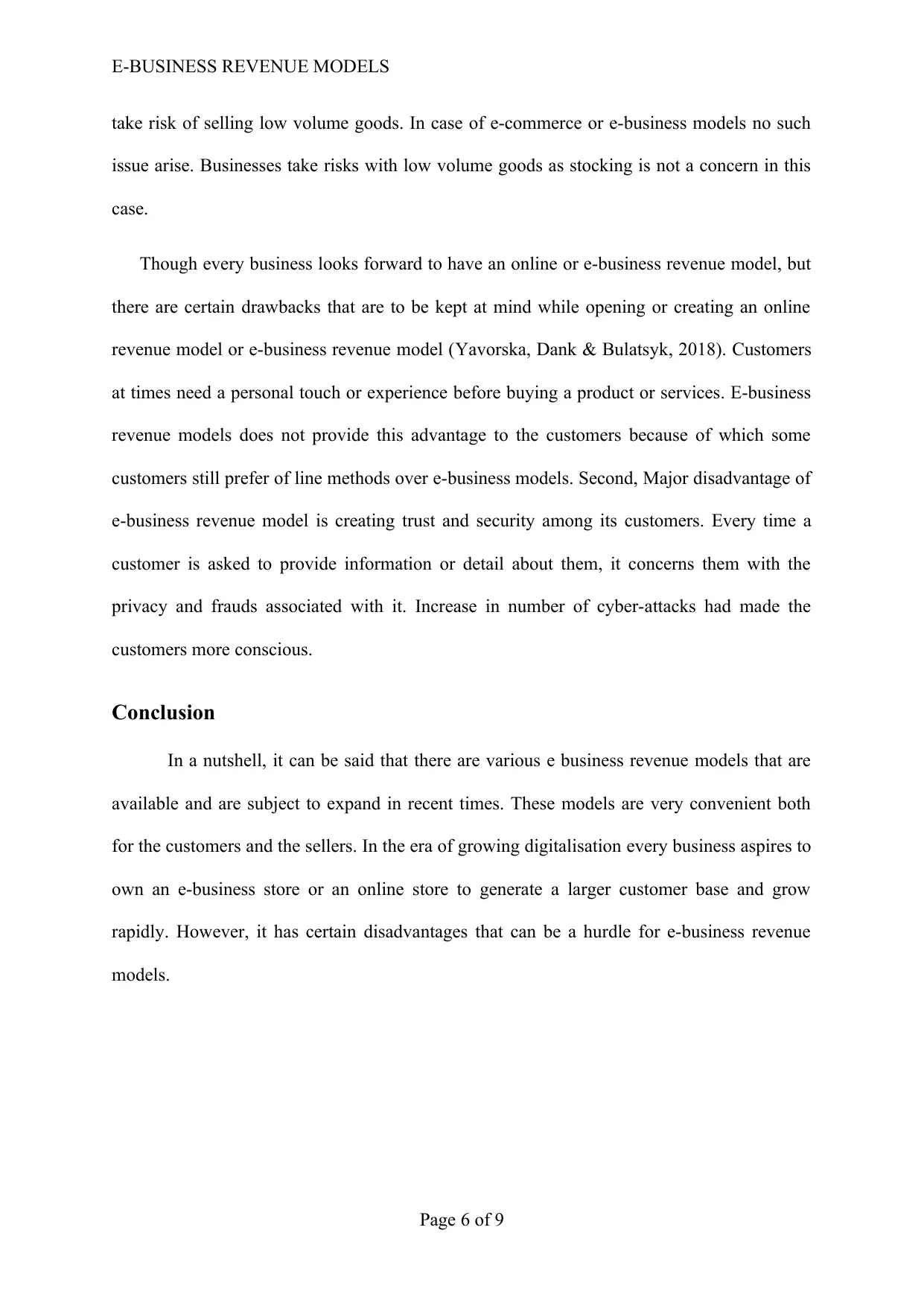
E-BUSINESS REVENUE MODELS
take risk of selling low volume goods. In case of e-commerce or e-business models no such
issue arise. Businesses take risks with low volume goods as stocking is not a concern in this
case.
Though every business looks forward to have an online or e-business revenue model, but
there are certain drawbacks that are to be kept at mind while opening or creating an online
revenue model or e-business revenue model (Yavorska, Dank & Bulatsyk, 2018). Customers
at times need a personal touch or experience before buying a product or services. E-business
revenue models does not provide this advantage to the customers because of which some
customers still prefer of line methods over e-business models. Second, Major disadvantage of
e-business revenue model is creating trust and security among its customers. Every time a
customer is asked to provide information or detail about them, it concerns them with the
privacy and frauds associated with it. Increase in number of cyber-attacks had made the
customers more conscious.
Conclusion
In a nutshell, it can be said that there are various e business revenue models that are
available and are subject to expand in recent times. These models are very convenient both
for the customers and the sellers. In the era of growing digitalisation every business aspires to
own an e-business store or an online store to generate a larger customer base and grow
rapidly. However, it has certain disadvantages that can be a hurdle for e-business revenue
models.
Page 6 of 9
take risk of selling low volume goods. In case of e-commerce or e-business models no such
issue arise. Businesses take risks with low volume goods as stocking is not a concern in this
case.
Though every business looks forward to have an online or e-business revenue model, but
there are certain drawbacks that are to be kept at mind while opening or creating an online
revenue model or e-business revenue model (Yavorska, Dank & Bulatsyk, 2018). Customers
at times need a personal touch or experience before buying a product or services. E-business
revenue models does not provide this advantage to the customers because of which some
customers still prefer of line methods over e-business models. Second, Major disadvantage of
e-business revenue model is creating trust and security among its customers. Every time a
customer is asked to provide information or detail about them, it concerns them with the
privacy and frauds associated with it. Increase in number of cyber-attacks had made the
customers more conscious.
Conclusion
In a nutshell, it can be said that there are various e business revenue models that are
available and are subject to expand in recent times. These models are very convenient both
for the customers and the sellers. In the era of growing digitalisation every business aspires to
own an e-business store or an online store to generate a larger customer base and grow
rapidly. However, it has certain disadvantages that can be a hurdle for e-business revenue
models.
Page 6 of 9
Paraphrase This Document
Need a fresh take? Get an instant paraphrase of this document with our AI Paraphraser
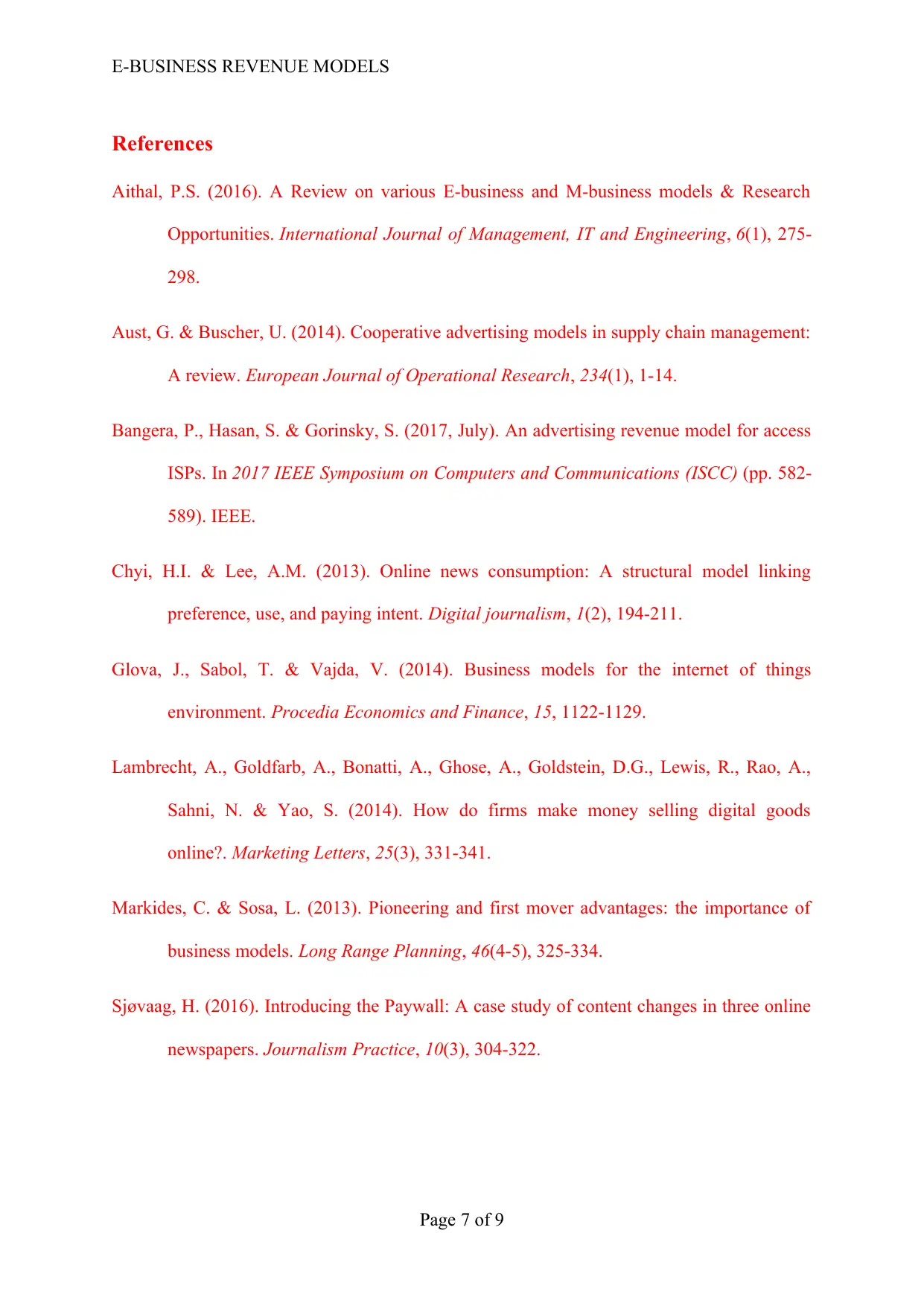
E-BUSINESS REVENUE MODELS
References
Aithal, P.S. (2016). A Review on various E-business and M-business models & Research
Opportunities. International Journal of Management, IT and Engineering, 6(1), 275-
298.
Aust, G. & Buscher, U. (2014). Cooperative advertising models in supply chain management:
A review. European Journal of Operational Research, 234(1), 1-14.
Bangera, P., Hasan, S. & Gorinsky, S. (2017, July). An advertising revenue model for access
ISPs. In 2017 IEEE Symposium on Computers and Communications (ISCC) (pp. 582-
589). IEEE.
Chyi, H.I. & Lee, A.M. (2013). Online news consumption: A structural model linking
preference, use, and paying intent. Digital journalism, 1(2), 194-211.
Glova, J., Sabol, T. & Vajda, V. (2014). Business models for the internet of things
environment. Procedia Economics and Finance, 15, 1122-1129.
Lambrecht, A., Goldfarb, A., Bonatti, A., Ghose, A., Goldstein, D.G., Lewis, R., Rao, A.,
Sahni, N. & Yao, S. (2014). How do firms make money selling digital goods
online?. Marketing Letters, 25(3), 331-341.
Markides, C. & Sosa, L. (2013). Pioneering and first mover advantages: the importance of
business models. Long Range Planning, 46(4-5), 325-334.
Sjøvaag, H. (2016). Introducing the Paywall: A case study of content changes in three online
newspapers. Journalism Practice, 10(3), 304-322.
Page 7 of 9
References
Aithal, P.S. (2016). A Review on various E-business and M-business models & Research
Opportunities. International Journal of Management, IT and Engineering, 6(1), 275-
298.
Aust, G. & Buscher, U. (2014). Cooperative advertising models in supply chain management:
A review. European Journal of Operational Research, 234(1), 1-14.
Bangera, P., Hasan, S. & Gorinsky, S. (2017, July). An advertising revenue model for access
ISPs. In 2017 IEEE Symposium on Computers and Communications (ISCC) (pp. 582-
589). IEEE.
Chyi, H.I. & Lee, A.M. (2013). Online news consumption: A structural model linking
preference, use, and paying intent. Digital journalism, 1(2), 194-211.
Glova, J., Sabol, T. & Vajda, V. (2014). Business models for the internet of things
environment. Procedia Economics and Finance, 15, 1122-1129.
Lambrecht, A., Goldfarb, A., Bonatti, A., Ghose, A., Goldstein, D.G., Lewis, R., Rao, A.,
Sahni, N. & Yao, S. (2014). How do firms make money selling digital goods
online?. Marketing Letters, 25(3), 331-341.
Markides, C. & Sosa, L. (2013). Pioneering and first mover advantages: the importance of
business models. Long Range Planning, 46(4-5), 325-334.
Sjøvaag, H. (2016). Introducing the Paywall: A case study of content changes in three online
newspapers. Journalism Practice, 10(3), 304-322.
Page 7 of 9

E-BUSINESS REVENUE MODELS
Yavorska, N., Danko, T. & Bulatsyk, S. (2018). INTERNET COMMERCE IN UKRAINE:
THE SPECIFICS, ADVANTAGES AND DISADVANTAGES. In Science and
education: trends and prospects (pp. 121-125).
Page 8 of 9
Yavorska, N., Danko, T. & Bulatsyk, S. (2018). INTERNET COMMERCE IN UKRAINE:
THE SPECIFICS, ADVANTAGES AND DISADVANTAGES. In Science and
education: trends and prospects (pp. 121-125).
Page 8 of 9
⊘ This is a preview!⊘
Do you want full access?
Subscribe today to unlock all pages.

Trusted by 1+ million students worldwide
1 out of 9
Related Documents
Your All-in-One AI-Powered Toolkit for Academic Success.
+13062052269
info@desklib.com
Available 24*7 on WhatsApp / Email
![[object Object]](/_next/static/media/star-bottom.7253800d.svg)
Unlock your academic potential
Copyright © 2020–2025 A2Z Services. All Rights Reserved. Developed and managed by ZUCOL.





